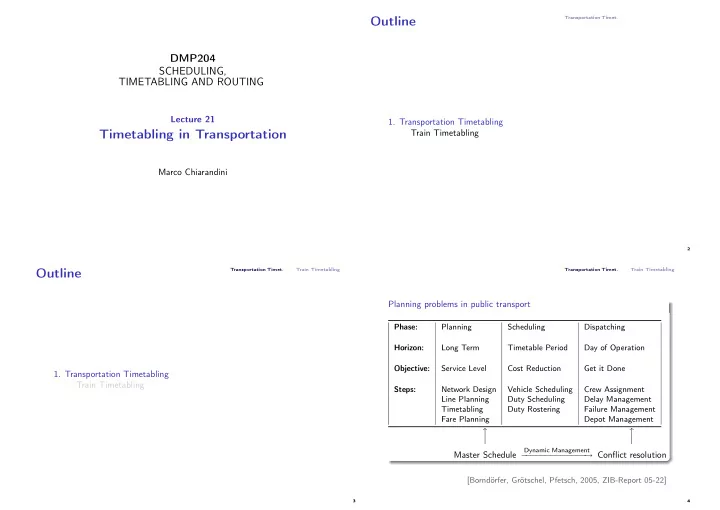

Transportation Timet. Outline DMP204 SCHEDULING, TIMETABLING AND ROUTING Lecture 21 1. Transportation Timetabling Timetabling in Transportation Train Timetabling Marco Chiarandini 2 Transportation Timet. Train Timetabling Transportation Timet. Train Timetabling Outline Planning problems in public transport Phase: Planning Scheduling Dispatching Horizon: Long Term Timetable Period Day of Operation Objective: Service Level Cost Reduction Get it Done 1. Transportation Timetabling Train Timetabling Steps: Network Design Vehicle Scheduling Crew Assignment Line Planning Duty Scheduling Delay Management Timetabling Duty Rostering Failure Management Fare Planning Depot Management � � Dynamic Management Master Schedule − − − − − − − − − − − − − → Conflict resolution [Borndörfer, Grötschel, Pfetsch, 2005, ZIB-Report 05-22] 3 4
Transportation Timet. Train Timetabling Transportation Timet. Train Timetabling [Borndörfer, Liebchen, Pfetsch, course 2006, TU Berlin] [Borndörfer, Liebchen, Pfetsch, course 2006, TU Berlin] 5 6 Transportation Timet. Train Timetabling Transportation Timet. Train Timetabling Train Timetabling Time-space diagram Input: Corridors made up of two independent one-way tracks L links between L + 1 stations. T set of trains and T j , T j ⊆ T , subset of trains that pass through link j Output: We want to find a periodic (eg, one day) timetable for the trains on one track (the other can be mirrored) that specifies: y ij = time train i enters link j z ij = time train i exists link j such that specific constraints are satisfied and costs minimized. [Borndörfer, Liebchen, Pfetsch, course 2006, TU Berlin] 7 9
Transportation Timet. Train Timetabling Transportation Timet. Train Timetabling Constraints: Solution Approach Minimal time to traverse one link All constraints and costs can be modeled in a MIP with the variables: Minimum stopping times at stations to allow boarding y ij , z ij and x ihj = { 0 , 1 } indicating if train i precedes train h Minimum headways between consecutive trains on each link for Two dummy trains T ′ and T ′′ with fixed times are included to safety reasons compact and make periodic Trains can overtake only at train stations There are some “ predetermined ” upper and lower bounds on arrival Large model solved heuristically by decomposition. and departure times for certain trains at certain stations Key Idea: insert one train at a time and solve a simplified MIP. Costs due to: deviations from some “ preferred ” arrival and departure times for In the simplified MIP the order in each link of trains already certain trains at certain stations scheduled is maintained fixed while times are recomputed. The only order not fixed is the one of the new train inserted k ( x ihj simplifies deviations of the travel time of train i on link j to x ij which is 1 if k is inserted in j after train i ) deviations of the dwelling time of train i at station j 10 11 Transportation Timet. Train Timetabling Overall Algorithm Step 1 (Initialization) Introduce in T 0 two “dummy trains” as first and last trains Step 2 (Select an Unscheduled Train) Select the next train k through the train selection priority rule Step 3 (Set up and preprocess the MIP) Include train k in set T 0 Set up MIP(K) for the selected train k Preprocess MIP(K) to reduce number of 0–1 variables and constraints Step 4 (Solve the MIP) Solve MIP(k). If algorithm does not yield feasible solution STOP. Otherwise, add train k to the list of already scheduled trains and fix for each link the sequences of all trains in T 0 . Step 5 (Reschedule all trains scheduled earlier) Consider the current partial schedule that includes train k . For each train i ∈ { T 0 − k } delete it and reschedule it Step 6 (Stopping criterion) If T 0 consists of all train, then STOP otherwise go to Step 2. 12
Recommend
More recommend